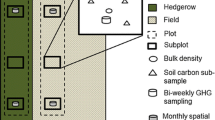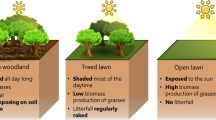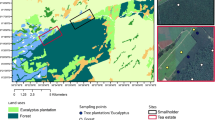Abstract
Urban green spaces provide important ecosystem services, such as amenity, biodiversity, productivity, climate amelioration, hydrological and biogeochemical cycling. Intensively managed urban gardens can sequester carbon through vegetation growth and soil C increase, but may experience nitrous oxide (N2O) emissions and reduced soil methane (CH4) uptake from irrigation and fertiliser use. Soil atmosphere exchange of N2O, CH4 and carbon dioxide (CO2) was measured in lawn and wood chip mulched garden areas in Melbourne, Australia in winter, spring and summer under various water and fertiliser regimes. Gas exchange before and after lawn fertiliser application was measured continuously for three weeks using an automated chamber system. Applying fertiliser led to a peak N2O emission of >60 μg N m−2 h−1, but overall only weekly irrigation (10 mm) significantly increased mean soil N2O emissions above that in other treatments. Under mulch, mean soil N2O emissions (14.0 μg N m−2 h−1) were significantly smaller than from irrigated lawn (27.9 μg N m−2 h−1), whereas mean soil CH4 uptake under mulch (−30.7 μg C m−2 h−1) was significantly greater (p < 0.01) than in any lawn treatment. Lawns were either a weak CH4 sink or source. Soil C density (0–25 cm) under mulch (12.5 kg C m−2) was greater that under lawn (8.0 kg C m−2). On a carbon dioxide equivalent (CO2-e) basis, soil N2O emissions offset the benefits of soil CH4 uptake. Mulched garden areas provide greatest C sequestration potential in soil and vegetation and the smallest non-CO2 emissions, as soil CH4 uptake offsets a large fraction of soil N2O emissions. Results of this study suggest that reducing the irrigation and fertiliser application to lawns can help mitigate GHG emissions from urban garden systems, and increasing the area of mulched perennial garden beds can also provide net GHG benefits; however, this needs to be tested in other garden systems with different soil types and environmental conditions.






Similar content being viewed by others
References
ABS (2006) Year book Australia, 2006. Cat. no. 1301.0. Australian Bureau of Statistics, Canberra
Aulakh MS, Doran JW, Walters DT, Mosier AR, Francis DD (1991) Crop residue type and placement effects on denitrification and mineralization. Soil Sci Soc Am J 55:1020–1025
Ball BC, Dobbie KE, Parker JP, Smith KA (1997) The influence of gas transport and porosity on methane oxidation in soils. J Geophys Res-Atmos 102:23301–23308
Barnett G, Doherty M, Beaty M (2005) Urban greenspace: connecting people and nature. 2nd ‘State of Australian Cities’ Conference. Griffith University, Queensland
Barrett JE, Burke IC (2000) Potential nitrogen immobilization in grassland soils across a soil organic matter gradient. Soil Biol Biochem 32:1707–1716
Barton L, Kiese R, Gatter R, ButterbachBahl K, Buck R et al (2008) Nitrous oxide emissions from a cropped soil in a semi-arid climate. Global Change Biol 14:177–192
Bijoor NS, Czimczik CI, Pataki DE, Billings SA (2008) The effects of temperature and fertilization on nitrogen cycling and community composition of an urban lawn. Global Change Biol 14:2119–2131
Bowden RD, Davidson E, Savage K, Arabia C, Steudler P (2004) Chronic nitrogen additions reduce total soil respiration and microbial respiration in temperate forest soils at the Harvard Forest. For Ecol Manag 196:43–56
Bremer DJ (2006) Nitrous oxide fluxes in turfgrass: effects of nitrogen fertilization rates and types. J Environ Qual 35:1678–1685
Burton AJ, Pregitzer KS, Crawford JN, Zogg GP, Zak DR (2004) Simulated chronic NO −3 deposition reduces soil respiration in northern hardwood forests. Global Change Biol 10:1080–1091
Butterbach-Bahl K, Gasche R, Breuer L, Papen H (1997) Fluxes of NO and N2O from temperate forest soils: impact of forest type, N deposition and of liming on the NO and N2O emissions. Nutr Cycl Agroecosyst 48:79–90
Byrne KA (2006) Effect of urban habitat types and landscape patternson ecological variables at the aboveground-belwoground interface. PhD Dissertation, Pennsylvania State University
Byrne KA, Kiely G (2006) Partitioning of respiration in an intensively managed grassland. Plant Soil 282:281–289
Byrne LB, Bruns MA, Kim KC (2008) Ecosystem properties of urban land covers at the aboveground-belowground interface. Ecosystems 11:1065–1077
Castro MS, Steudler PA, Melillo JM, Aber JD, Bowden RD (1995) Factors controlling atmospheric methane consumption by temperate forest soils. Global Biogeochem Cycles 9:1–10
Chu HY, Hosen Y, Yagi K (2007) NO, N2O, CH4 and fluxes in winter barley field of Japanese Andisol as affected by N fertilizer management. Soil Biol Biochem 39:330–339
Conrad R (1996) Soil microorganisms as controllers of atmospheric trace gases (H-2, CO, CH4, OCS, N2O, and NO). Microbiol Rev 60:609–640
Crutzen PJ, Mosier RA, Smith KA, Winiwater W (2007) N2O release from agro-biofuel production negates global warming reduction by replacing fossil fuels. Atmos Chem Phys Discuss 7:11191–11205
Dalal R, Allen D, Livesley S, Richards G (2008) Magnitude and biophysical regulators of methane emission and consumption in the Australian agricultural, forest, and submerged landscapes: a review. Plant Soil 309:43–76
Dobbie KE, Smith KA (2003) Impact of different forms of N fertilizer on N2O emissions from intensive grassland. Nutr Cycl Agroecosyst 67:37–46
Fang C, Moncrieff JB (2001) The dependence of soil CO2 efflux on temperature. Soil Biol Biochem 33:155–165
Fernandes SAP, Bernoux M, Cerri CC, Feigl BJ, Piccolo MC (2002) Seasonal variation of soil chemical properties and CO2 and CH4 fluxes in unfertilized and P-fertilized pastures in an Ultisol of the Brazilian Amazon. Geoderma 107:227–241
Firestone MK, Davidson EA (1989) Microbiological basis on NO and N2O production and consumption in soils. In: Andreae MO, Schimel D (eds) Exchange of trace gases between terrestrial ecosystems and the atmosphere. Wiley, Chichester, pp 7–21
Flechard CR, Ambus P, Skiba U, Rees RM, Hensen A et al (2007) Effects of climate and management intensity on nitrous oxide emissions in grassland systems across Europe. Agric Ecosyst Environ 121:135–152
Fleischer S, Bouse I (2008) Nitrogen cycling drives a strong within-soil CO2-sink. Tellus B-Chem Phys Meteorol 60:782–786
Golubiewski NE (2006) Urbanization increases grassland carbon pools: effects of landscaping in Colorado’s front range. Ecol Appl 16:555–571
Grimm NB, Faeth SH, Golubiewski NE, Redman CL, Wu JG et al (2008) Global change and the ecology of cities. Science 319:756–760
Groffman PM, Pouyat RV (2009) Methane uptake in urban forests and lawns. Environ Sci Tech 43:5229–5235
Hall SJ, Huber D, Grimm NB (2008) Soil N2O and NO emissions from an arid, urban ecosystem. J Geophys Res Biogeosci 113. doi:10.1029/2007JG000523
Hutsch BW (2001) Methane oxidation in non-flooded soils as affected by crop production—invited paper. Eur J Agron 14:237–260
Imhoff ML, Tucker CJ, Lawrence WT, Stutzer DC (2000) The use of multisource satellite and geospatial data to study the effect of urbanization on primary productivity in the United States. Geosci Rem Sens 38:2549–2556
IPCC (2007) Climate change 2007: the physical science basis. Contribution of working group I to the fourth assessment report of the intergovernmental panel on climate change. Cambridge University Press, Cambridge
Isbell R (2002) The Australian soil classification. CSIRO, Canberra, Australia
Jacinthe PA, Lal R (2004) Effects of soil cover and land-use on the relations flux-concentration of trace gases. Soil Sci 169:243–259
Janssens IA, Pilegaard K (2003) Large seasonal changes in Q10 of soil respiration in a beech forest. Global Change Biol 9:911–918
Jones GW (2002) Southeast Asian urbanisation and the growth of mega-urban regions. J Popul Res 19:119–136
Kaye JP, Burke IC, Mosier AR, Guerschman JP (2004) Methane and nitrous oxide fluxes from urban soils to the atmosphere. Ecol Appl 14:975–981
Kaye JP, McCulley RL, Burke IC (2005) Carbon fluxes, nitrogen cycling, and soil microbial communities in adjacent urban, native and agricultural ecosystems. Global Change Biol 11:575–587
Kaye JP, Groffman PM, Grimm NB, Baker LA, Pouyat RV (2006) A distinct urban biogeochemistry? Trends Ecol Evol 21:192–199
Kerek M, Drijber RA, Powers MJ, Shearman RC, Gaussoin RE et al (2002) Accumulation of microbial biomass within particulate organic matter of aging golf greens. Agron J 94:455–461
Koerner B, Klopatek J (2002) Anthropogenic and natural CO2 emission sources in an arid urban environment. Environ Pollut 116:S45–S51
Livesley S, Kiese R, Graham J, Weston C, Butterbach-Bahl K et al (2008) Trace gas flux and the influence of short-term soil water and temperature dynamics in Australian sheep grazed pastures of differing productivity. Plant Soil 309:89–103
Maggiotto SR, Webb JA, Wagner-Riddle C, Thurtell GW (2000) Nitrous and nitrogen oxide emissions from turfgrass receiving different forms of nitrogen fertilizer. J Environ Qual 29:621–630
Milesi C, Running SW, Elvidge CD, Dietz JB, Tuttle BT et al (2005) Mapping and modeling the biogeochemical cycling of turf grasses in the United States. Environ Manage 36:426–438
Mosier AR, Delgado JA (1997) Methane and nitrous oxide fluxes in grasslands in western Puerto Rico. Chemosphere 35:2059–2082
Mosier A, Schimel D, Valentine D, Bronson K, Parton W (1991) Methane and nitrous-oxide fluxes in native, fertilized and cultivated grasslands. Nature 350:330–332
Nowak DJ, Crane DE (2002) Carbon storage and sequestration by urban trees in the USA. Environ Pollut 116:381–389
Pataki DE, Alig RJ, Fung AS, Golubiewski NE, Kennedy CA et al (2006) Urban ecosystems and the North American carbon cycle. Global Change Biol 12:2092–2102
Perez-Batallon P, Ouro G, Macias F, Merino A (2001) Initial mineralization of organic matter in a forest plantation soil following different logging residue management techniques. Ann Forest Sci 58:807–818
Pouyat RV, Yesilonis ID, Nowak DJ (2006) Carbon storage by urban soils in the United States. J Environ Qual 35:1566–1575
Priest MW, Williams DJ, Bridgman HA (2000) Emissions from in-use lawn-mowers in Australia. Atmos Environ 34:657–664
Qian YL, Follett RF (2002) Assessing soil carbon sequestration in turfgrass systems using long-term soil testing data. Agron J 94:930–935
Rey A, Petsikos C, Jarvis PG, Grace J (2005) Effect of temperature and moisture on rates of carbon mineralization in a Mediterranean oak forest soil under controlled and field conditions. Eur J Soil Sci 56:589–599
Robertson GP, Paul EA, Harwood RR (2000) Greenhouse gases in intensive agriculture: contributions of individual gases to the radiative forcing of the atmosphere. Science 289:1922–1925
Saggar S, Andrew RM, Tate KR, Hedley CB, Rodda NJ et al (2004) Modelling nitrous oxide emissions from dairy-grazed pastures. Nutr Cycl Agroecosyst 68:243–255
Searchinger T, Heimlich R, Houghton RA, Dong FX, Elobeid A et al (2008) Use of US croplands for biofuels increases greenhouse gases through emissions from land-use change. Science 319:1238–1240
Simek M, Elhottova D, Klimes F, Hopkins DW (2004) Emissions of N2O and CO2, denitrification measurements and soil properties in red clover and ryegrass stands. Soil Biol Biochem 36:9–21
Singh BK, Tate KR, Kolipaka G, Hedley CB, Macdonald CA et al (2007) Effect of afforestation and reforestation of pastures on the activity and population dynamics of methanotrophic bacteria. Appl Environ Microbiol 73:5153–5161
Soussana JF, Fuhrer J, Jones M, Van Amstel A (2007) The greenhouse gas balance of grasslands in Europe. Agric Ecosyst Environ 121:1–4
Tiquia SM, Lloyd J, Herms DA, Hoitink HAJ, Michel FC (2002) Effects of mulching and fertilization on soil nutrients, microbial activity and rhizosphere bacterial community structure determined by analysis of TRFLPs of PCR-amplified 16S rRNA genes. Appl Soil Ecol 21:31–48
Tratalos J, Fuller RA, Warren PH, Davies RG, Gaston KJ (2007) Urban form, biodiversity potential and ecosystem services. Landsc Urban Plann 83:308–317
UNFPA (2007) State of the world population 2007—unleashing the potential of urban growth. United Nations Population Fund, New York, USA
van den Pol-van Dasselaar A, van Beusichem ML, Oenema O (1998) Effects of soil moisture content and temperature on methane uptake by grasslands on sandy soils. Plant Soil 204:213–222
van den Pol-Van Dasselaar A, van Beusichem ML, Oenema O (1999a) Determinants of spatial variability of methane emissions from wet grasslands on peat soil. Biogeochemistry 44:221–237
van den Pol-van Dasselaar AV, van Beusichem ML, Oenema O (1999b) Effects of nitrogen input and grazing on methane fluxes of extensively and intensively managed grasslands in the Netherlands. Biol Fertil Soils 29:24–30
Veldkamp E, Keller M, Nunez M (1998) Effects of pasture management on N2O and NO emissions from soils in the humid tropics of Costa Rica. Global Biogeochem Cycles 12:71–79
Wilson HM, Al-Kaisi MM (2008) Crop rotation and nitrogen fertilization effect on Soil CO2 emissions in central lowa. Appl Soil Ecol 39:264–270
Acknowledgements
The authors would like to thank Andrew Smith and the Burnley gardeners for their assistance in enabling this research project, and Alex Campbell, Nick Osborne and Jamie Pearson for facilities and equipment. Thanks to Grant Harper for assistance in map preparation. We would also like to thank Matt Lee from the Creswick laboratories for analytical assistance and Dr Andrew Hamilton for assistance in statistical analysis. We would also like to acknowledge that the manuscript was greatly improved with the extensive and constructive comments of two anonymous reviewers and the section editor. This research project was partially funded by Australian Research Council Linkage Grant LP0455475 and the Victorian Greenhouse Strategy of the Department of Sustainability and Environment of Victoria.
Author information
Authors and Affiliations
Corresponding author
Rights and permissions
About this article
Cite this article
Livesley, S.J., Dougherty, B.J., Smith, A.J. et al. Soil-atmosphere exchange of carbon dioxide, methane and nitrous oxide in urban garden systems: impact of irrigation, fertiliser and mulch. Urban Ecosyst 13, 273–293 (2010). https://doi.org/10.1007/s11252-009-0119-6
Published:
Issue Date:
DOI: https://doi.org/10.1007/s11252-009-0119-6




